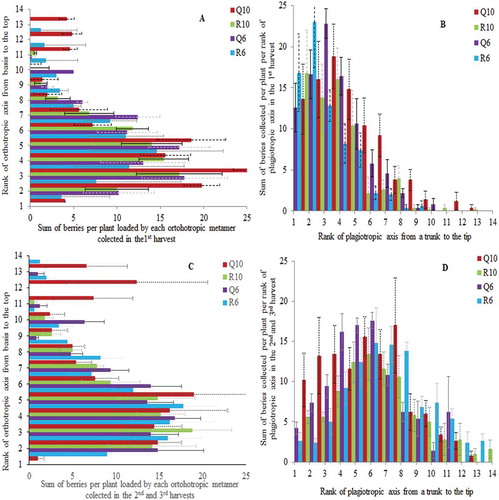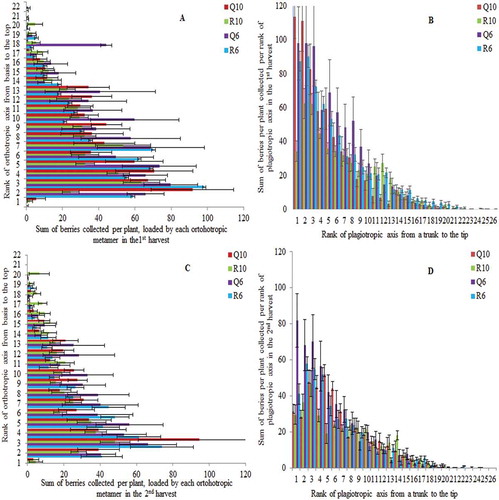Figures & data
Figure 1. Mean and standard error values of sum of berries per plant distributed over vertical (A and C) and horizontal profile, on the second-order axes (B and D), in the first production year (2010). The sum of berries collected in the first harvest is shown on upper line and sum of berries collected in the second and third harvests is represented at lower line. Plants were cultivated under two planting patterns (Q – square and R – rectangular) and densities (10,000 and 6000 plants ha−1).

Table 1. ANOVA P-values for the effects of planting density (Dens, 10,000 and 6000 plants ha−1), planting pattern (PP, Q – square and R – rectangular) and rank of orthotropic and plagiotropic axes on the berry distribution in the first production year during the first and later harvests (second + third).
Figure 2. Mean and standard error values of sum of berries per plant distributed over vertical (A and C) and horizontal profile, on the second-order axes (B and D), in the second production year (2011). The sum of berries collected in the first harvest is shown on upper line and sum of berries collected in the second harvest is represented at lower line. Plants were cultivated under two planting patterns (Q – square and R – rectangular) and densities (10,000 and 6000 plants ha−1).

Table 2. ANOVA P-values for the effects of planting density (Dens, 10,000 and 6000 plants ha−1), planting pattern (PP, Q – square and R – rectangular), occurrence over the 40-cm-thick layers and rank of orthotropic and plagiotropic axes on the berry distribution in the second production year during the first and second harvests.
Table 3. Means (g 100 g−1) and Tukey test following by ANOVA P-values for the effects of production year (PY, first and second after the low tree pruning), planting densities (Dens, 10,000 and 6000 plants ha−1) and patterns (PP, Q – square and R – rectangular) on chemical compounds of coffee beans.
Table 4. Means (g 100 g−1) and Tukey test following by ANOVA P-values for the effects of harvest periods, planting densities (Dens, 10,000 and 6000 plants ha−1) and patterns (PP, Q – square and R – rectangular) on chemical compounds of coffee beans in the first production year.
Table 5. Means (g 100 g−1) and Tukey test following by ANOVA P-values for the effects of harvest periods, planting densities (Dens, 10,000 and 6000 plants ha−1) and patterns (PP, Q – square and R – rectangular) on chemical compounds of coffee beans in the second production year.
Table 6. Means (g 100 g−1) and Tukey test following by ANOVA P-values for the effects of vertical profile localization of coffee berries over the 40-cm-thick layers, planting densities (Dens), and patterns (PP) on chemical compounds of coffee beans in the second PY.
